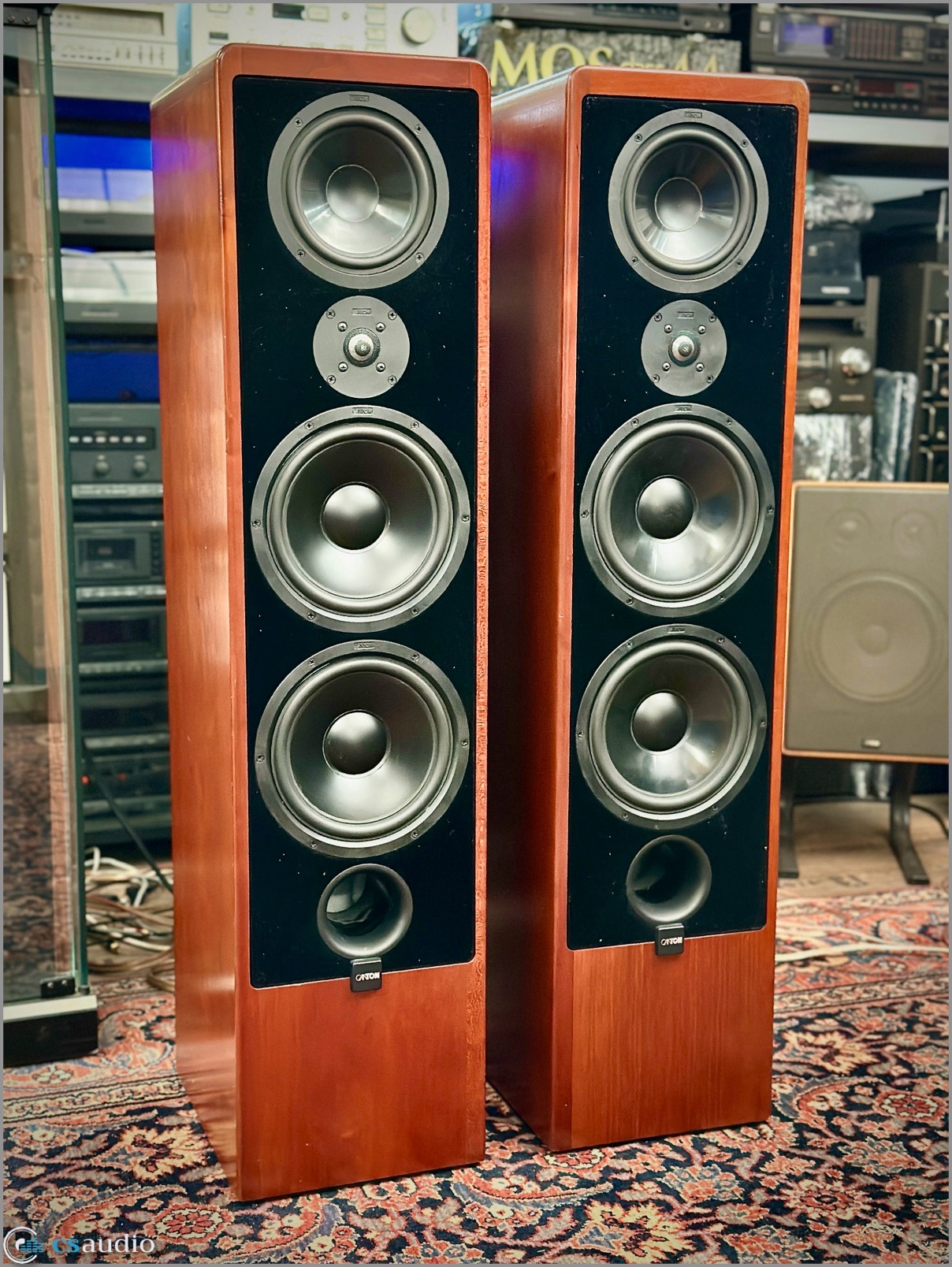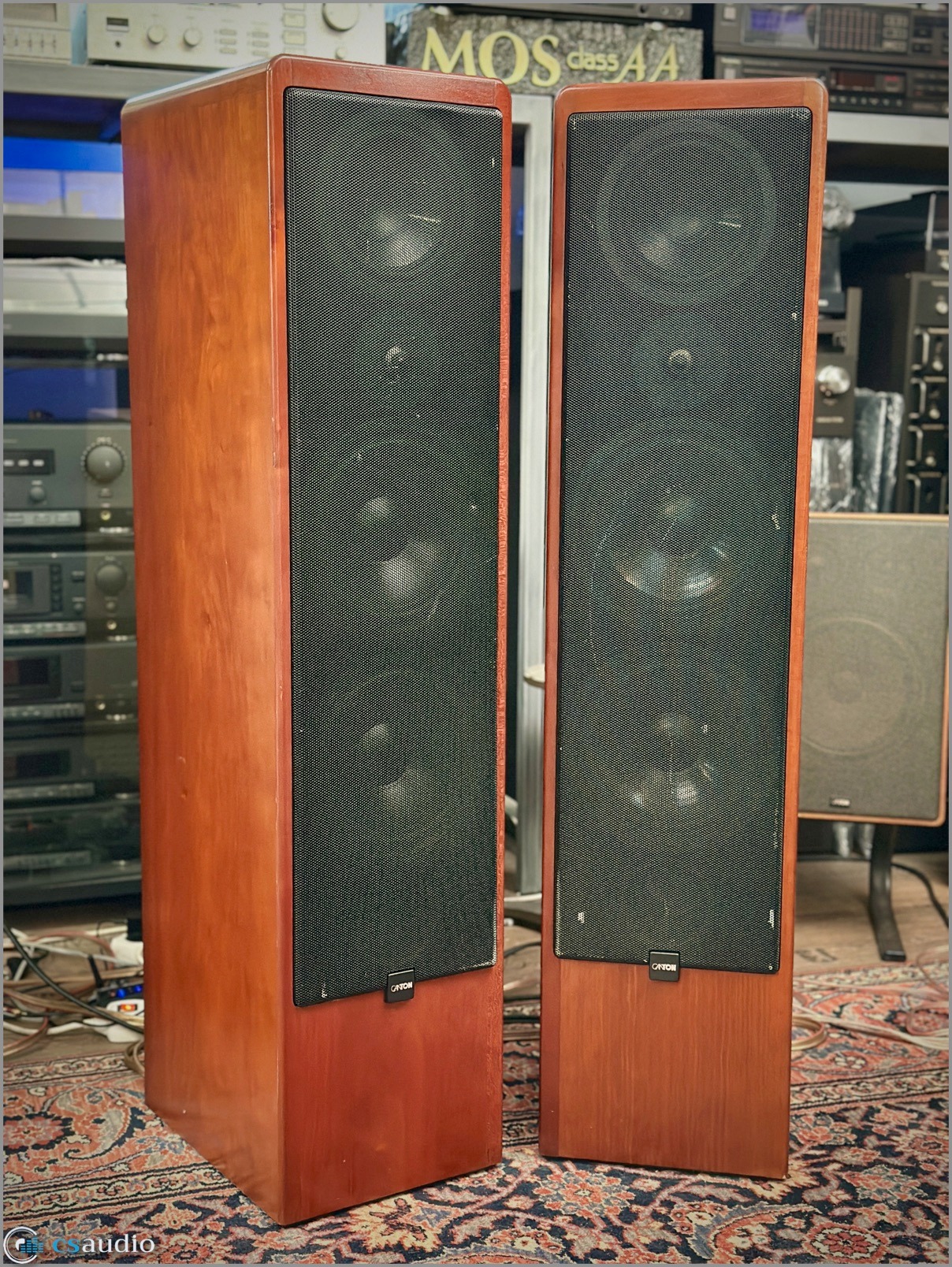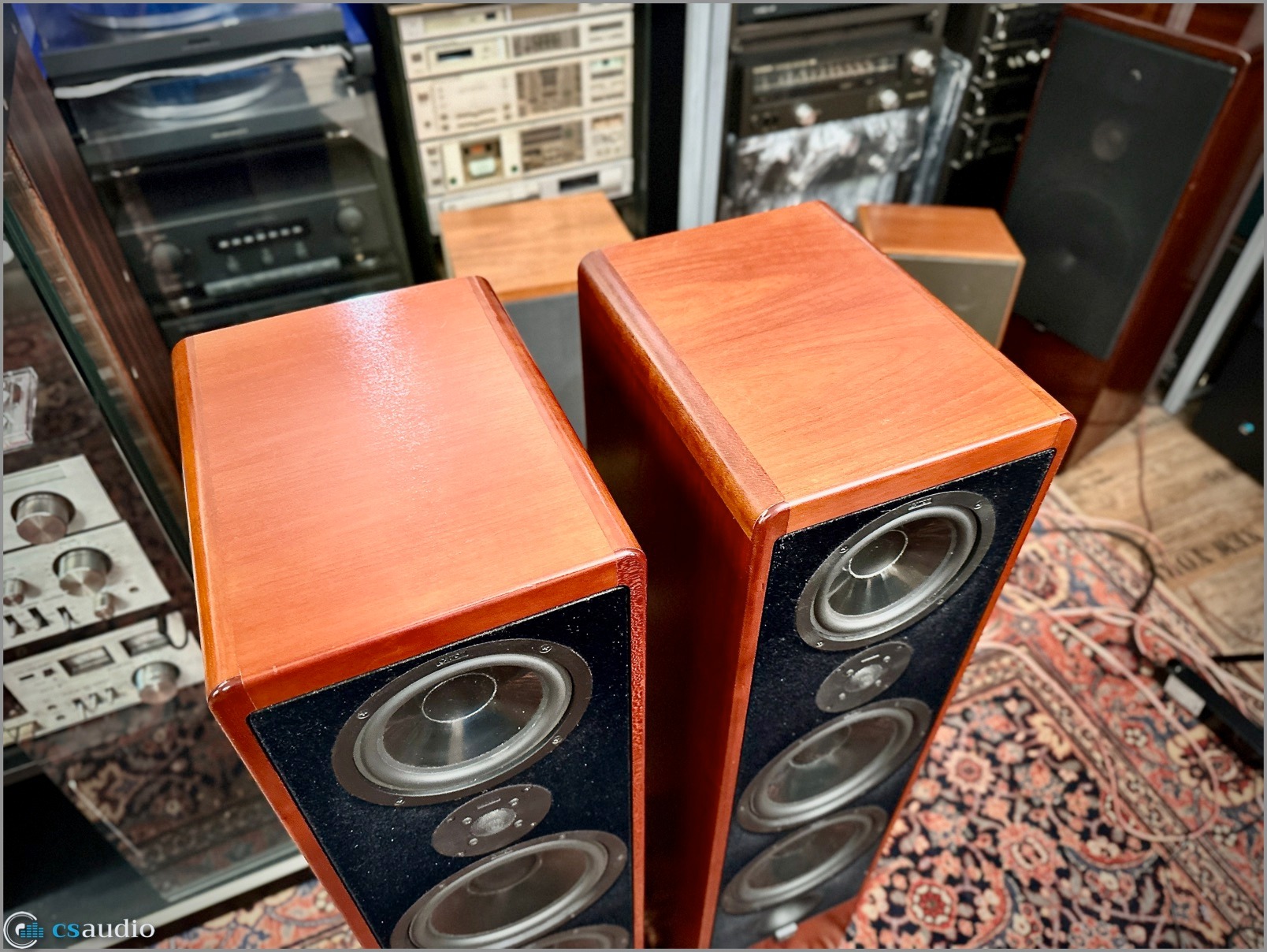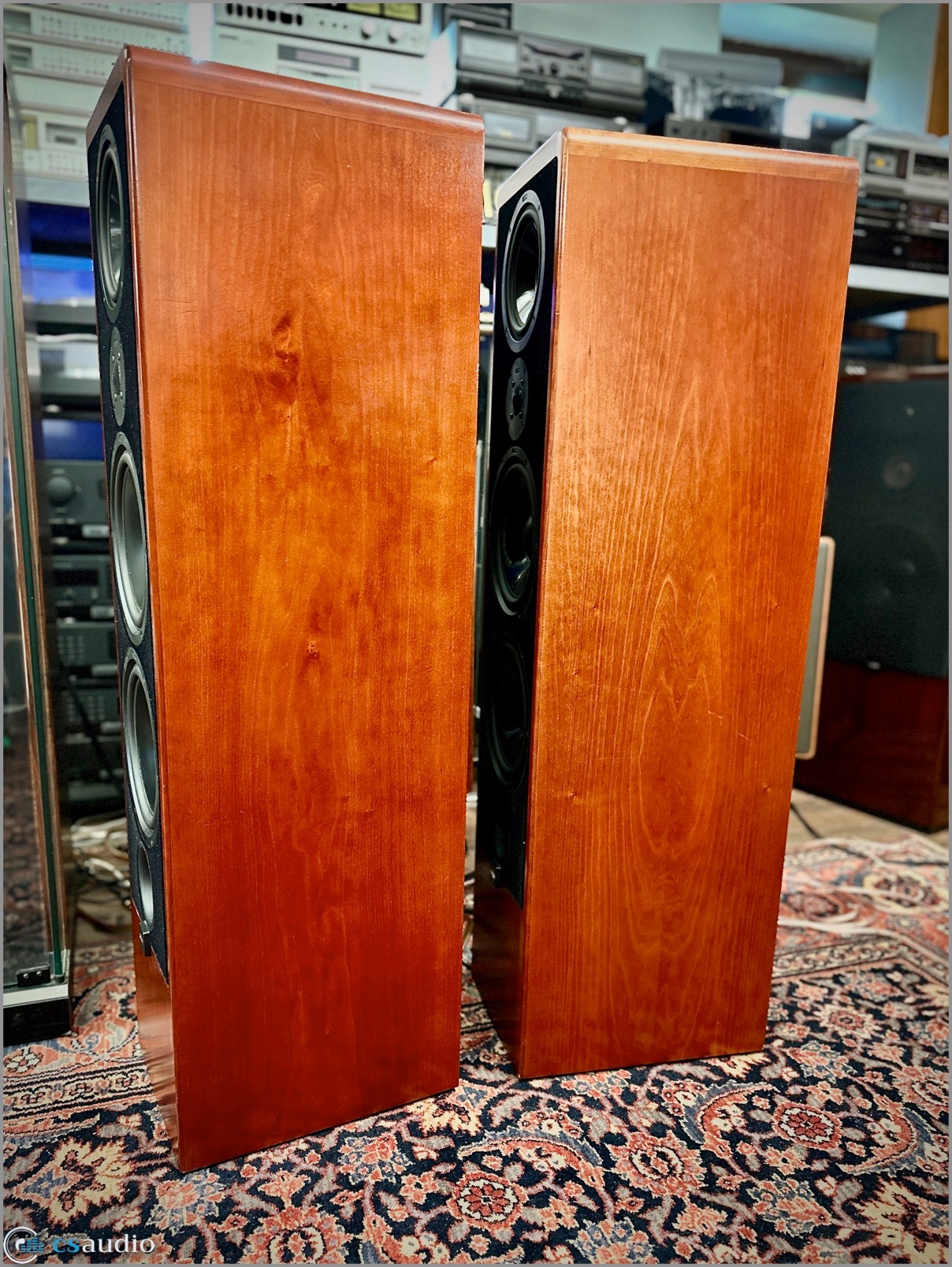Difference between revisions of "Canton Ergo RC-L"
(→Daten) |
(→Pictures) |
||
| (2 intermediate revisions by one other user not shown) | |||
| Line 1: | Line 1: | ||
__NOTOC__ | __NOTOC__ | ||
| − | == | + | == Data == |
| − | {{ | + | {{navigation}} |
| − | ''' | + | '''General''' |
| − | * | + | * Manufacturer: [[Canton]] |
| − | * | + | * Model: Ergo RC-L |
| − | * | + | * Years of manufacture: 1998 - 2000 (available as a discontinued model until 2008) |
| − | * | + | * Made in: Germany |
| − | * | + | * Colour: beech, cherry, ash black |
| − | * | + | * Dimensions: 1100 x 260 x 347 mm (H x W x D) |
| − | * | + | * Weight: approx. 32 kg |
| − | * | + | * List price per pair approx.: 10.000.-DM |
| − | ''' | + | '''Technical Data''' |
| − | * | + | * Type: 3-way, bass reflex, floorstanding speaker |
* Chassis: | * Chassis: | ||
| − | ** | + | ** woofer: 2x 220 mm |
| − | + | Midrange driver: 1x 180 mm | |
| − | + | tweeter: 1x 25 mm aluminium-manganese dome tweeter | |
| − | * | + | * Power handling (nominal/music): 200 / 350 Watt |
| − | * | + | * Efficiency: 89.7 dB/1W/1m |
| − | * | + | * Frequency response: 18 - 30.000 Hz |
| − | * | + | * Transitional ranges: 300 / 3,500 Hz |
| − | * | + | * Impedance: 4...8 Ohm |
| − | ''' | + | '''Special Features''' |
| − | + | Control unit with power supply 'Canton Control Unit' (black box) for bass and treble equalisation; is looped in between preamplifier and power amplifier. Bass and treble can be adjusted in 5 steps (-2,-1,0,+1,+2). If the Control Unit is not used, the crossover network would theoretically have to be adjusted to compensate for the built-in frequency response influences in the bass and treble and to achieve a linear frequency response. | |
| − | + | Connector panel of the Control Unit with 4 connectors Main in/out - Tape in/out | |
| − | + | The Control Unit of the RC-L has the number 4040 and is exactly matched to the loudspeaker. The predecessor SC-L can exceptionally be used with it (although there was also a very rare own adjustable control unit for the SC-L). The unit is not intended for the RC-S or RC-K, however. These have their own control units, which are exactly tuned to them. It is simply a bad habit to use the control units with each other or even worse to use them with other loudspeakers. When used with other speakers, even the amplifier can quickly become overloaded (clipping, distortion). | |
| − | + | Here is a list of the controllable Control Units: | |
| − | Fonissimo RC: RC 2 (4050) | + | * Fonissimo RC: RC 2 (4050) |
| − | Ergo SC-L: SC-L/RC (0227): | + | Ergo SC-L: SC-L/RC (0227): The adjustable special model of the Ergo SC-L (exceptionally the unit of the RC-L can be used as well) |
| − | Ergo RC-L: RC 1 (4040) | + | * Ergo RC-L: RC 1 (4040) |
| − | Ergo RC-S: RC 3 (4774) | + | * Ergo RC-S: RC 3 (4774) |
| − | Ergo RC-K: RC 4 (5196) | + | * Ergo RC-K: RC 4 (5196) |
| − | == | + | == Remarks == |
| − | * | + | * It's better to use this speaker only in rooms with at least 20m²; in smaller rooms the bass is too strong. The bass frequency goes down to 25Hz at (-3dB). The position of the LS should also not be too close to the corner of the room. |
| − | + | The RC-L has a very low impedance in the bass range, which means that very stable and powerful amplifiers are required that have the necessary damping factor to elicit the RC-L's full potential. | |
| − | + | As with the other RC models (exception: RC-A) the RC-L only achieves its full sound and frequency range in conjunction with the associated control unit (black box), which is connected between the pre-amplifier and the power amplifier and linearises the frequency response, compensates for errors in the frequency response and lowers the bass range so that the loudspeaker also reaches the specified lower limiting frequency. Without the control unit the full sound spectrum of the RC-L is by far not achieved. Unfortunately, since about 2005 there are no more separate receivers/amplifiers (Pre-Out and Main-In), and also the analogue looping in by means of a tape monitor is no longer possible. Nowadays, the unit can only be looped in between the preamplifier and power amplifier, or a receiver/amplifier can be separated. This is the only way to play digital sources perfectly. Unfortunately, the use of these speakers is very limited nowadays. With Control Unit the RC-L sound "full-bodied", analytical and with a wide stage (less in the depth) when set up correctly and with load stable amplifiers ... does not need a subwoofer. Without a control unit, however, I would prefer their Ergo counterpart 102. | |
| − | * | + | * Other models in the same series: |
Canton Ergo RC-K | Canton Ergo RC-K | ||
Canton Ergo RC-S | Canton Ergo RC-S | ||
| − | + | Predecessor model: | |
Canton Ergo SC-L | Canton Ergo SC-L | ||
| − | + | successor model: | |
| − | + | Without | |
| − | == | + | == Pictures == |
| − | + | [[image:CANTON ERGO RC-L f.jpg]] | |
| − | + | [[image:CANTON ERGO RC-L f2.jpg]] | |
| + | [[image:CANTON ERGO RC-L u.jpg]] | ||
| + | [[image:CANTON ERGO RC-L s.jpg]] | ||
| + | [[image:CANTON ERGO RC-L b.jpg]] | ||
| − | == | + | == Reports == |
| − | + | Comparison test in Stereoplay 1/1998: "What the Canton Ergo RCL was able to achieve in bass and low bass was unrivalled in the test field (Cabasse Brick 500, ESS ES 261, Heco Metron 1000, Linn AV 5140, Tannoy DB 500). Even the testers rarely get to hear a lower frequency range that is so rich in depth and so stable in level. And the Canton didn't sound like a wheelhouse, but exemplary balanced and with little coloration. (...) The Canton Ergo RCL sounded so strong that one rightly has to ask why a loudspeaker like this or, for example, the Elac CL 202, also from Germany, are never actually called high-end." - Sound rating: very good, 23 points / price-performance: outstanding / stereoplay highlight | |
== Links == | == Links == | ||
| − | [[ | + | [[Category:Loudspeakers]] |
Latest revision as of 04:53, 30 November 2025
Data
General
- Manufacturer: Canton
- Model: Ergo RC-L
- Years of manufacture: 1998 - 2000 (available as a discontinued model until 2008)
- Made in: Germany
- Colour: beech, cherry, ash black
- Dimensions: 1100 x 260 x 347 mm (H x W x D)
- Weight: approx. 32 kg
- List price per pair approx.: 10.000.-DM
Technical Data
- Type: 3-way, bass reflex, floorstanding speaker
- Chassis:
- woofer: 2x 220 mm
Midrange driver: 1x 180 mm tweeter: 1x 25 mm aluminium-manganese dome tweeter
- Power handling (nominal/music): 200 / 350 Watt
- Efficiency: 89.7 dB/1W/1m
- Frequency response: 18 - 30.000 Hz
- Transitional ranges: 300 / 3,500 Hz
- Impedance: 4...8 Ohm
Special Features
Control unit with power supply 'Canton Control Unit' (black box) for bass and treble equalisation; is looped in between preamplifier and power amplifier. Bass and treble can be adjusted in 5 steps (-2,-1,0,+1,+2). If the Control Unit is not used, the crossover network would theoretically have to be adjusted to compensate for the built-in frequency response influences in the bass and treble and to achieve a linear frequency response.
Connector panel of the Control Unit with 4 connectors Main in/out - Tape in/out
The Control Unit of the RC-L has the number 4040 and is exactly matched to the loudspeaker. The predecessor SC-L can exceptionally be used with it (although there was also a very rare own adjustable control unit for the SC-L). The unit is not intended for the RC-S or RC-K, however. These have their own control units, which are exactly tuned to them. It is simply a bad habit to use the control units with each other or even worse to use them with other loudspeakers. When used with other speakers, even the amplifier can quickly become overloaded (clipping, distortion).
Here is a list of the controllable Control Units:
- Fonissimo RC: RC 2 (4050)
Ergo SC-L: SC-L/RC (0227): The adjustable special model of the Ergo SC-L (exceptionally the unit of the RC-L can be used as well)
- Ergo RC-L: RC 1 (4040)
- Ergo RC-S: RC 3 (4774)
- Ergo RC-K: RC 4 (5196)
Remarks
- It's better to use this speaker only in rooms with at least 20m²; in smaller rooms the bass is too strong. The bass frequency goes down to 25Hz at (-3dB). The position of the LS should also not be too close to the corner of the room.
The RC-L has a very low impedance in the bass range, which means that very stable and powerful amplifiers are required that have the necessary damping factor to elicit the RC-L's full potential. As with the other RC models (exception: RC-A) the RC-L only achieves its full sound and frequency range in conjunction with the associated control unit (black box), which is connected between the pre-amplifier and the power amplifier and linearises the frequency response, compensates for errors in the frequency response and lowers the bass range so that the loudspeaker also reaches the specified lower limiting frequency. Without the control unit the full sound spectrum of the RC-L is by far not achieved. Unfortunately, since about 2005 there are no more separate receivers/amplifiers (Pre-Out and Main-In), and also the analogue looping in by means of a tape monitor is no longer possible. Nowadays, the unit can only be looped in between the preamplifier and power amplifier, or a receiver/amplifier can be separated. This is the only way to play digital sources perfectly. Unfortunately, the use of these speakers is very limited nowadays. With Control Unit the RC-L sound "full-bodied", analytical and with a wide stage (less in the depth) when set up correctly and with load stable amplifiers ... does not need a subwoofer. Without a control unit, however, I would prefer their Ergo counterpart 102.
- Other models in the same series:
Canton Ergo RC-K Canton Ergo RC-S
Predecessor model: Canton Ergo SC-L
successor model: Without
Pictures
Reports
Comparison test in Stereoplay 1/1998: "What the Canton Ergo RCL was able to achieve in bass and low bass was unrivalled in the test field (Cabasse Brick 500, ESS ES 261, Heco Metron 1000, Linn AV 5140, Tannoy DB 500). Even the testers rarely get to hear a lower frequency range that is so rich in depth and so stable in level. And the Canton didn't sound like a wheelhouse, but exemplary balanced and with little coloration. (...) The Canton Ergo RCL sounded so strong that one rightly has to ask why a loudspeaker like this or, for example, the Elac CL 202, also from Germany, are never actually called high-end." - Sound rating: very good, 23 points / price-performance: outstanding / stereoplay highlight




